Spatiotemporal Patterns of Agriculture Expansion Intensity and Land-Use/Cover Changes in the Mixed Urban-Rural Upper Kafue River Basin of Zambia (1989–2019)
Abstract
1. Introduction
2. Literature Review
2.1. Agriculture Expansion
2.2. Agriculture Expansions and Land-Use Changes in River Basins
2.3. Studies from Other Important Basins in Sub-Saharan Africa and Globally
2.4. Mixed Urban–Rural Land-Cover Changes in Developing Countries
2.5. Comparative Studies from Other Continents
3. Materials and Methods
3.1. Study Area
3.2. Overall Workflow
3.3. Data
3.4. LULC Classification
3.4.1. PBC Technique
3.4.2. OBPR
3.4.3. Accuracy Assessment
3.5. LULC Change Detection
3.6. Agriculture Expansion and LULC Change Intensity Analysis
3.7. Directional Gradient Analysis
4. Results
4.1. LULC Maps and Accuracy
4.2. LULC Changes
4.3. Spatiotemporal Patterns of Agriculture Land Expansion and LULC Changes
4.4. Intensity of Agriculture Land Expansion and LULC Changes
4.5. Directional Gradient Analysis of Agriculture Expansion and LULC Changes
5. Discussion
5.1. LULC Maps and Accuracy
5.2. LULC Changes
5.3. Spatiotemporal Patterns of Agricultural Expansion
5.4. Intensity of Agricultural Land Expansion and LULC Changes
5.5. Directional Gradient Analysis of Agricultural Expansion and LULC Changes
5.6. Implications on Policy and Sustainable Management of River Basins
5.7. Limitations of the Study
6. Conclusions
Author Contributions
Funding
Institutional Review Board Statement
Data Availability Statement
Conflicts of Interest
Abbreviations
| LULC | Land-use land-cover |
| SDGs | Sustainable development goals |
| GIS | Geographic Information Systems |
| OBPR | Object-based post-classification refinement |
| PBC | Pixel-based classification |
References
- Lambin, E.F.; Turner, B.L.; Geist, H.J.; Agbola, S.B.; Angelsen, A.; Bruce, J.W.; Coomes, O.T.; Dirzo, R.; Fischer, G.; Folke, C.; et al. The causes of land-use and land-cover change: Moving beyond the myths. Glob. Environ. Chang. 2001, 11, 261–269. [Google Scholar] [CrossRef]
- Laurance, W.F.; Sayer, J.; Cassman, K.G. Agricultural expansion and its impacts on tropical nature. Trends Ecol. Evol. 2014, 29, 107–116. [Google Scholar] [CrossRef] [PubMed]
- Pontius, R.G.; Gao, Y.; Giner, N.M.; Kohyama, T.; Osaki, M.; Hirose, K. Design and interpretation of intensity analysis illustrated by land change in Central Kalimantan, Indonesia. Land 2013, 2, 351–369. [Google Scholar] [CrossRef]
- Gibbs, H.K.; Ruesch, A.S.; Achard, F.; Clayton, M.K.; Holmgren, P.; Ramankutty, N.; Foley, J.A. Tropical forests were the primary sources of new agricultural land in the 1980s and 1990s. Proc. Natl. Acad. Sci. USA 2010, 107, 16732–16737. [Google Scholar] [CrossRef]
- FAO. Assessing and Planning City Region Food System Kitwe (Zambia) Synthesis Report; FAO: Rome, Italy, 2018. [Google Scholar]
- Simwanda, M.; Murayama, Y. Spatiotemporal patterns of urban land use change in the rapidly growing city of Lusaka, Zambia: Implications for sustainable urban development. Sustain. Cities Soc. 2018, 39, 262–274. [Google Scholar] [CrossRef]
- Kalaba, F.K.; Quinn, C.H.; Dougill, A.J.; Vinya, R. Floristic composition, species diversity and carbon storage in charcoal and agriculture fallows and management implications in Miombo woodlands of Zambia. For. Ecol. Manag. 2013, 304, 99–109. [Google Scholar] [CrossRef]
- Mwangi, H.M.; Lariu, P.; Julich, S.; Patil, S.D.; McDonald, M.A.; Feger, K.H. Characterizing the intensity and dynamics of land-use change in the Mara River Basin, East Africa. Forests 2017, 9, 8. [Google Scholar] [CrossRef]
- Enaruvbe, G.O.; Pontius, R.G. Influence of classification errors on Intensity Analysis of land changes in southern Nigeria. Int. J. Remote Sens. 2015, 36, 244–261. [Google Scholar] [CrossRef]
- Huang, F.; Huang, B.; Huang, J.; Li, S. Measuring land change in coastal zone around a rapidly urbanized bay. Int. J. Environ. Res. Public Health 2018, 15, 1059. [Google Scholar] [CrossRef]
- 2020 Africa Sustainable Development Report 1; United Nations Economic Commission for Africa: Addis Ababa, Ethiopia, 2020.
- Casarotto, C. Water Economics and Governance in the Kafue River Basin, Zambia. Ph.D. Thesis, ETH Zürich, Zürich, Switzerland, 2013. [Google Scholar]
- Uhlendahl, T.; Salian, P.; Casarotto, C.; Doetsch, J. Good water governance and IWRM in Zambia: Challenges and chances. Water Policy 2011, 13, 845–862. [Google Scholar] [CrossRef][Green Version]
- UN-HABITAT. Zambia: Kitwe Urban Profile; UN-Habitat: Nairobi, Kenya, 2009. [Google Scholar]
- Central Statistical Office (CSO). 2010 Census of Population and Housing; Central Statistical Office (CSO): Lusaka, Zambia, 2012. [Google Scholar]
- Central Statistical Office (CSO). 2022 Census of Population and Housing.pdf; Central Statistical Office (CSO): Lusaka, Zambia, 2023. [Google Scholar]
- Aguirre-Gutiérrez, J.; Seijmonsbergen, A.C.; Duivenvoorden, J.F. Optimizing land cover classification accuracy for change detection, a combined pixel-based and object-based approach in a mountainous area in Mexico. Appl. Geogr. 2012, 34, 29–37. [Google Scholar] [CrossRef]
- Li, X.; Lei, L. Regional Sustainability Evaluating rural sustainable land use from a system perspective based on the ecosystem service value. Reg. Sustain. 2023, 4, 96–114. [Google Scholar]
- Simwanda, M.; Murayama, Y. Integrating geospatial techniques for urban land use classification in the developing sub-Saharan African City of Lusaka, Zambia. ISPRS Int. J. Geo-Inf. 2017, 6, 102. [Google Scholar] [CrossRef]
- Congalton, R.G. A review of assessing the accuracy of classification of remotely sensed data. Remote Sens. Environ. 1991, 37, 34–46. [Google Scholar] [CrossRef]
- Liu, S.; Qi, Z.; Li, X.; Yeh, A.G.O. Integration of convolutional neural networks and object-based post-classification refinement for land use and land cover mapping with optical and sar data. Remote Sens. 2019, 11, 690. [Google Scholar] [CrossRef]
- Subasinghe, S.; Wang, R.; Simwanda, M.; Murayama, Y.; Vitanova, L.L. Neighborhood dynamics of urban expansion based on morphological spatial pattern analysis and geospatial techniques: A case study of the Colombo metropolitan area, Sri Lanka. Asian Geogr. 2022, 39, 155–175. [Google Scholar] [CrossRef]
- Aldwaik, S.Z.; Pontius, R.G., Jr. Intensity analysis to unify measurements of size and stationarity of land changes by interval, category, and transition. Landsc. Urban Plan. 2012, 106, 103–114. [Google Scholar] [CrossRef]
- Zaehringer, J.G.; Eckert, S.; Messerli, P. Revealing Regional Deforestation Dynamics in North-Eastern Madagascar—Insights from Multi-Temporal Land Cover Change Analysis. Land 2015, 4, 454–474. [Google Scholar] [CrossRef]
- Luck, M.; Wu, J. A gradient analysis of urban landscape pattern: A case study from the Phoenix metropolitan region, Arizona, USA. Landsc. Ecol. 2002, 17, 327–339. [Google Scholar] [CrossRef]
- Estoque, R.C.; Murayama, Y.; Myint, S.W. Effects of landscape composition and pattern on land surface temperature: An urban heat island study in the megacities of Southeast Asia. Sci. Total Environ. 2017, 577, 349–359. [Google Scholar] [CrossRef]
- Ranagalage, M.; Wang, R.; Gunarathna, M.H.J.P.; Dissanayake, D.M.S.L.B.; Murayama, Y.; Simwanda, M. Spatial forecasting of the landscape in rapidly urbanizing hill stations of South Asia: A case study of Nuwara Eliya, Sri Lanka (1996–2037). Remote Sens. 2019, 11, 1743. [Google Scholar] [CrossRef]
- Hou, H.; Wang, R.; Murayama, Y. Scenario-based modelling for urban sustainability focusing on changes in cropland under rapid urbanization: A case study of Hangzhou from 1990 to 2035. Sci. Total Environ. 2019, 661, 422–431. [Google Scholar] [CrossRef] [PubMed]
- Zhou, X.; Wang, Y. Spatial—Temporal dynamics of urban green space in response to rapid urbanization and greening policies. Landsc. Urban Plan. 2011, 100, 268–277. [Google Scholar] [CrossRef]
- Hou, Y.; Müller, F.; Li, B.; Kroll, F. Urban-Rural Gradients of Ecosystem Services and the Linkages with Socioeconomics. Landsc. Online 2015, 31, 1–31. [Google Scholar] [CrossRef]
- Subasinghe, S.; Estoque, R.C.; Murayama, Y. Spatiotemporal Analysis of Urban Growth Using GIS and Remote Sensing: A Case Study of the Colombo Metropolitan Area, Sri Lanka. Int. J. Geo-Inf. 2016, 5, 197. [Google Scholar] [CrossRef]
- Li, X.; Wang, Y.; Li, J.; Lei, B. Physical and Socioeconomic Driving Forces of Land-Use and Land-Cover Changes: A Case Study of Wuhan City, China. Discret. Dyn. Nat. Soc. 2016, 2016, 8061069. [Google Scholar] [CrossRef]
- Schneibel, A.; Stellmes, M.; Röder, A.; Finckh, M.; Revermann, R.; Frantz, D.; Hill, J. Evaluating the trade-off between food and timber resulting from the conversion of Miombo forests to agricultural land in Angola using multi-temporal Landsat data. Sci. Total Environ. 2016, 548–549, 390–401. [Google Scholar] [CrossRef]
- Jayne, T.S.; Chapoto, A.; Sitko, N.; Nkonde, C.; Chamberlin, J. Eoreclosing a Smallholder Agricultural Expansion Strategy? J. Int. Aff. 2014, 67, 35–54. [Google Scholar]
- Phiri, D.; Mwitwa, J.; Ng, P.; Kanja, K. Agricultural Expansion into Forest Reserves in Zambia: A Remote Sensing Agricultural expansion into forest reserves in Zambia: A remote sensing approach. Geocarto Int. 2023, 38, 2213203. [Google Scholar] [CrossRef]
- Vinya, R.; Syampungani, S.; Kasumu, E.; Monder, C.; Kasubika, R. Preliminary Study on the Drivers of Deforestation and Potential for REDD+ in Zambia; UN Environment Programme: Nairobi, Kenya, 2011; p. 66. [Google Scholar]
- Simwanda, M.; Murayama, Y.; Ranagalage, M. Land Use Policy Modeling the drivers of urban land use changes in Lusaka, Zambia using multi-criteria evaluation: An analytic network process approach. Land Use Policy 2020, 92, 104441. [Google Scholar] [CrossRef]
- Elias, E.; Seifu, W.; Tesfaye, B.; Girmay, W. Impact of land use/cover changes on lake ecosystem of Ethiopia central rift valley. Cogent Food Agric. 2019, 5, 1595876. [Google Scholar] [CrossRef]
- Jiang, L.; Deng, X.; Seto, K.C. The impact of urban expansion on agricultural land use intensity in China. Land Use Policy 2013, 35, 33–39. [Google Scholar] [CrossRef]
- Olokeogun, O.S.; Ayanlade, A.; Popoola, O.O. Assessment of riparian zone dynamics and its flood—Related implications in Eleyele area of Ibadan, Nigeria. Environ. Syst. Res. 2020, 9, 6. [Google Scholar] [CrossRef]
- Hamilton, S.K.; Hussain, M.Z.; Lowrie, C.; Basso, B.; Robertson, G.P. Evapotranspiration is resilient in the face of land cover and climate change in a humid temperate catchment. Hydrol. Process. 2018, 32, 655–663. [Google Scholar] [CrossRef]
- Zhou, P.; Huang, J.; Pontius, R.G.; Hong, H. Land classification and change intensity analysis in a coastal watershed of Southeast China. Sensors 2014, 14, 11640–11658. [Google Scholar] [CrossRef]
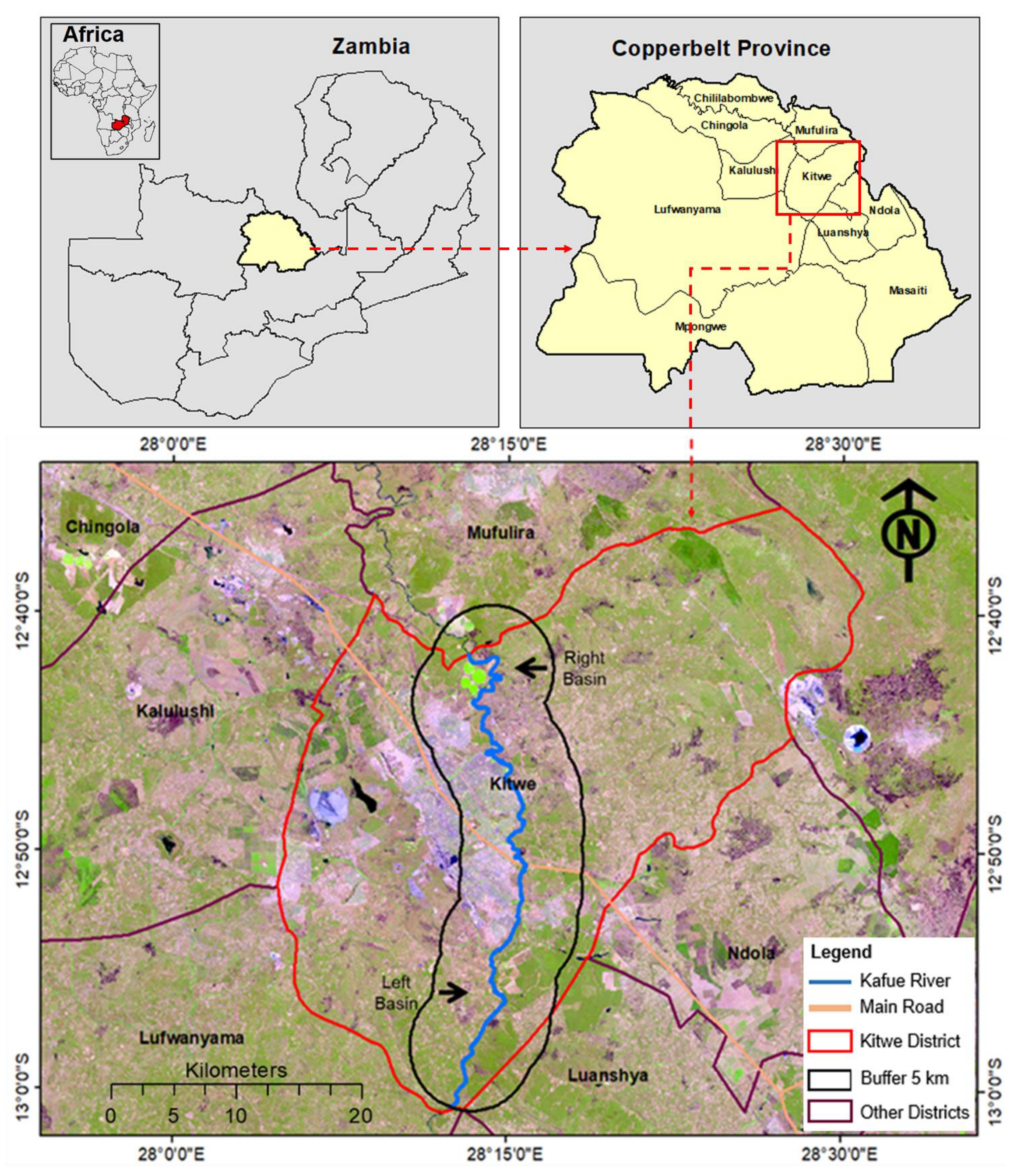
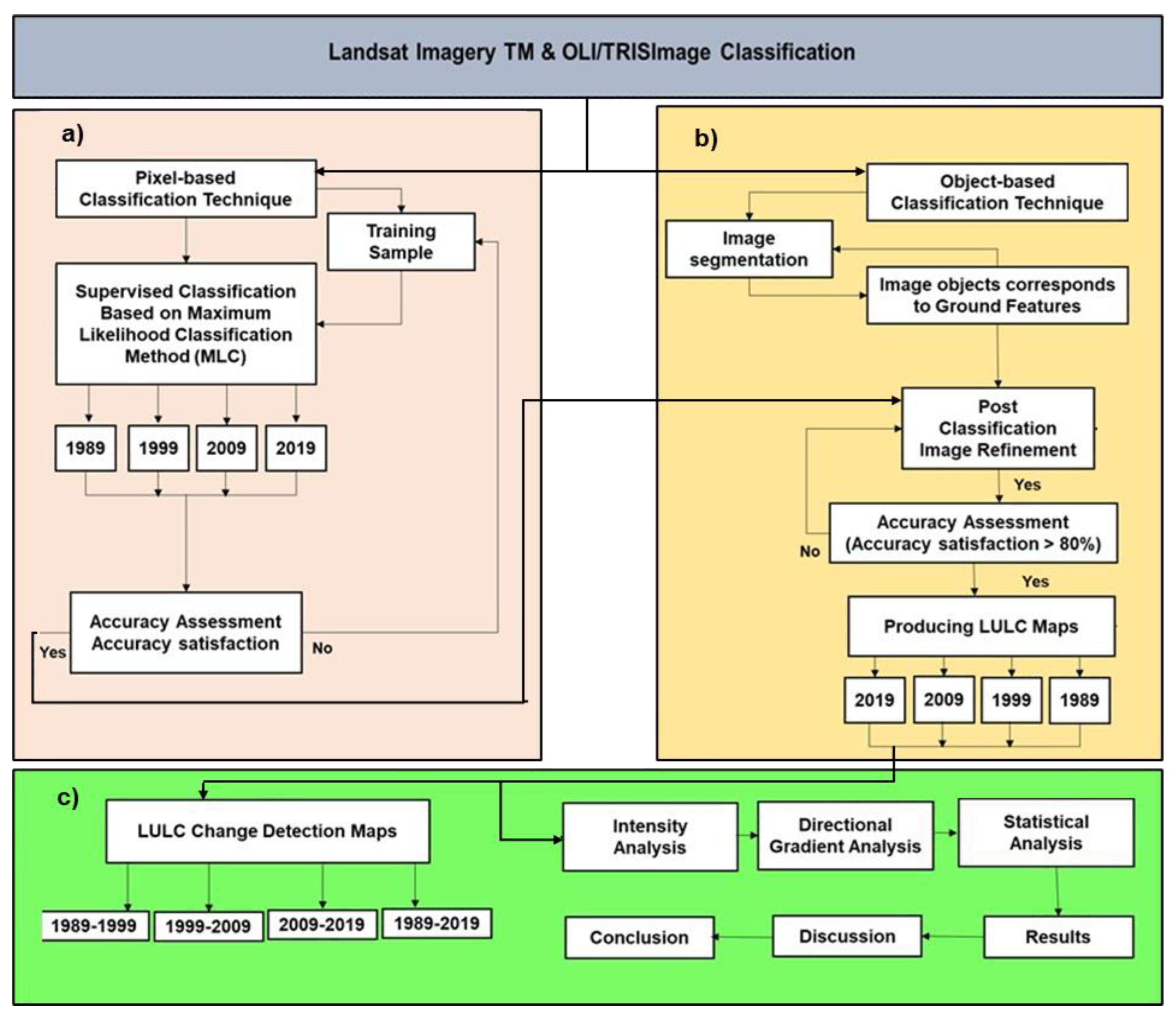
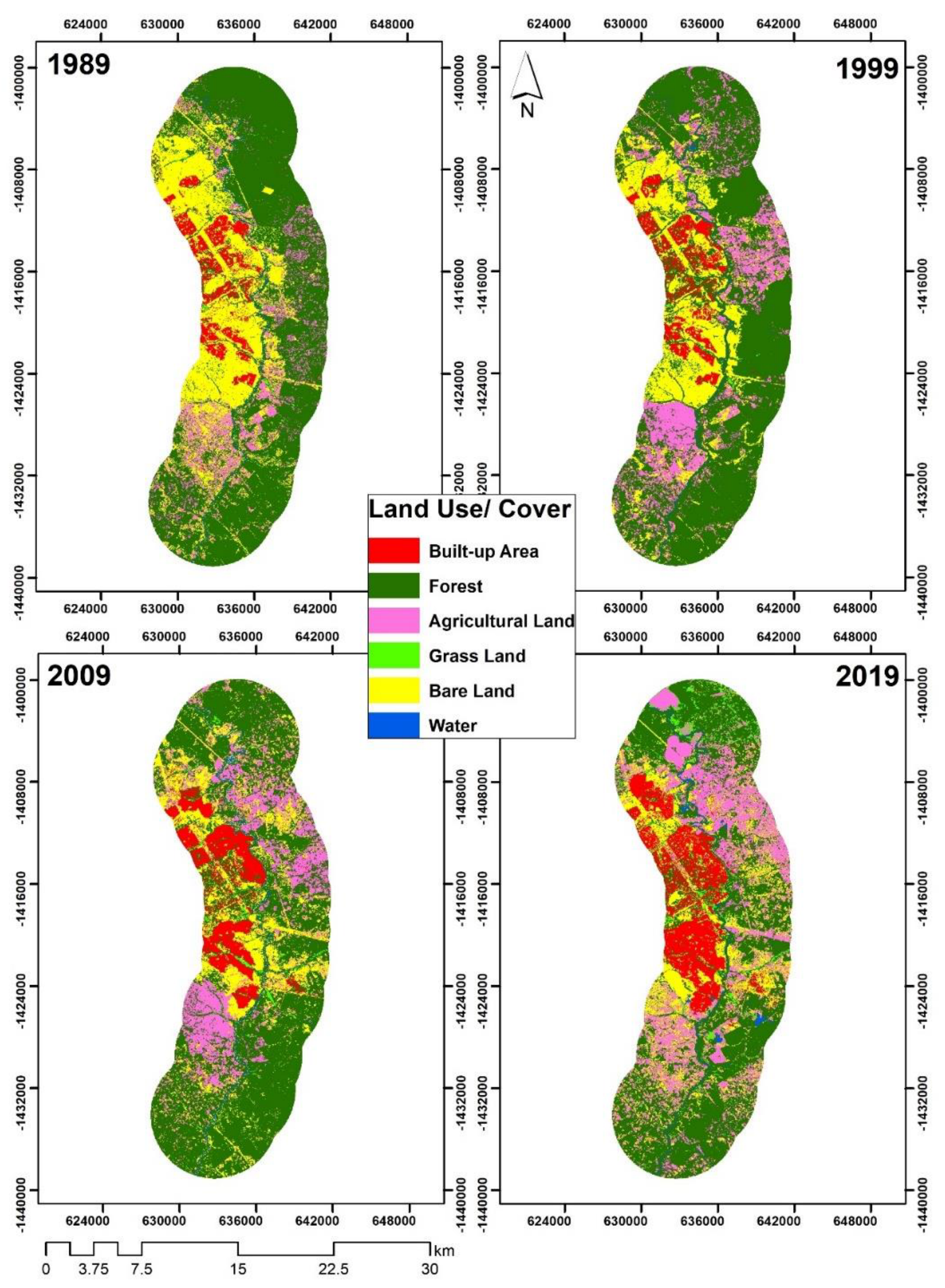
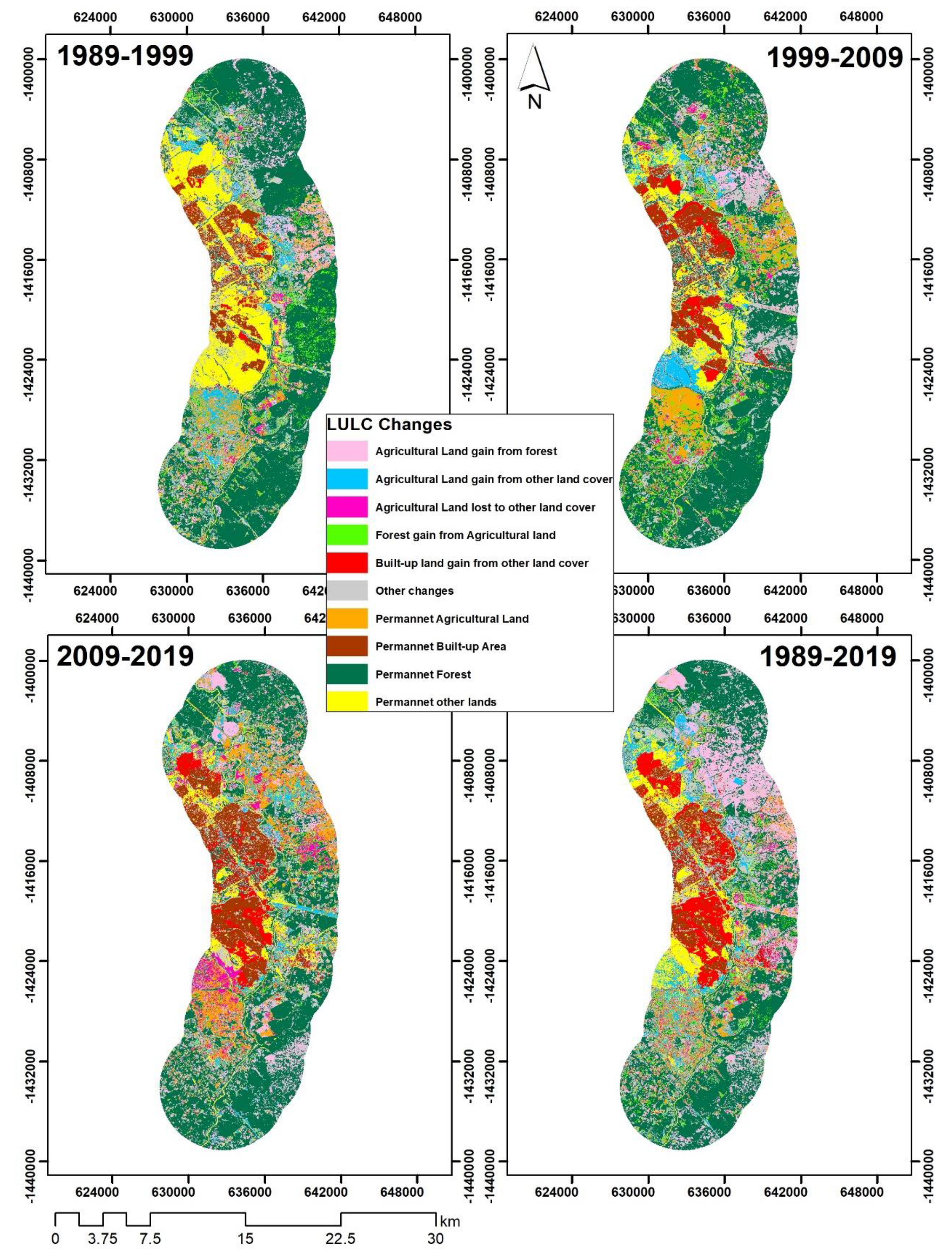
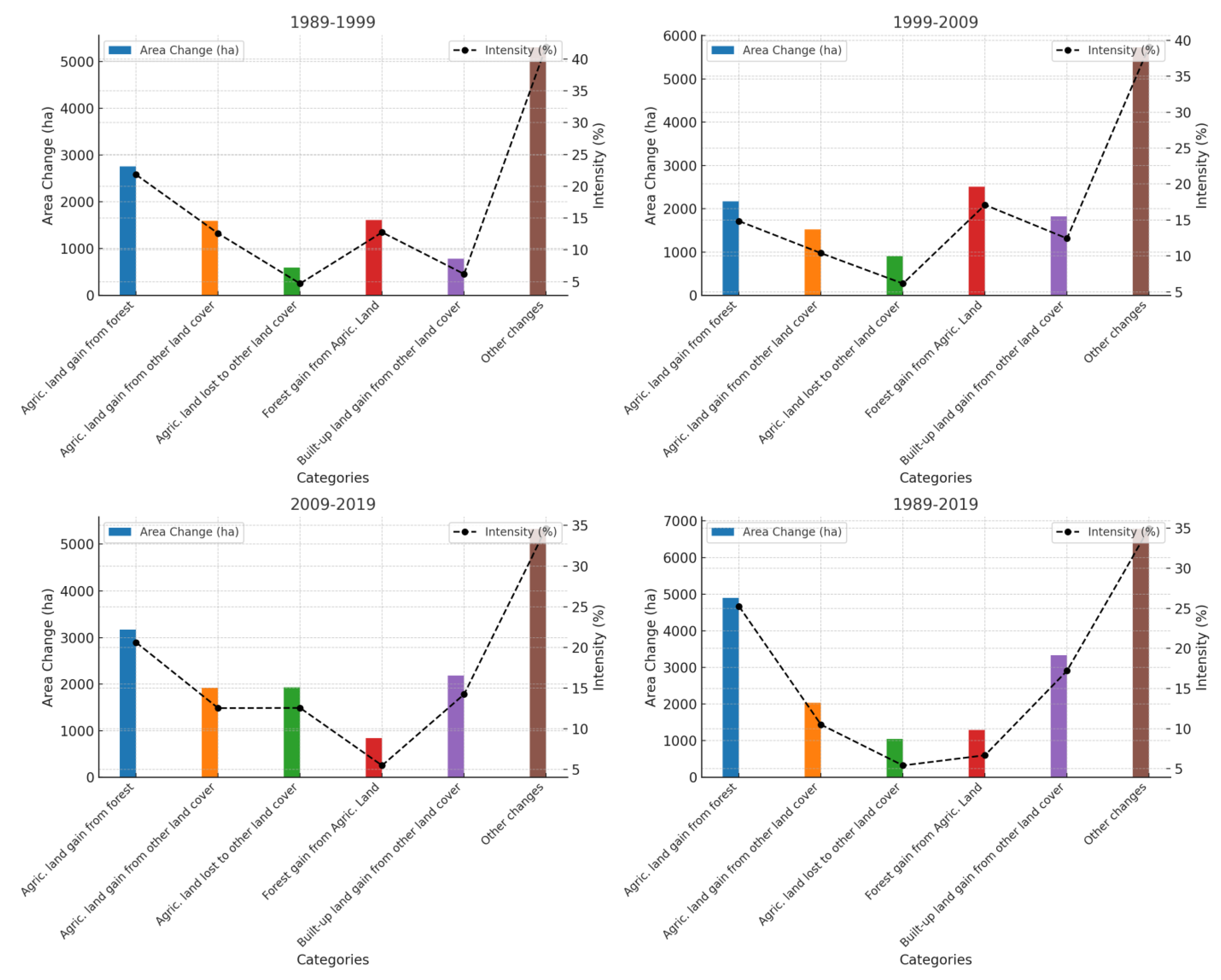
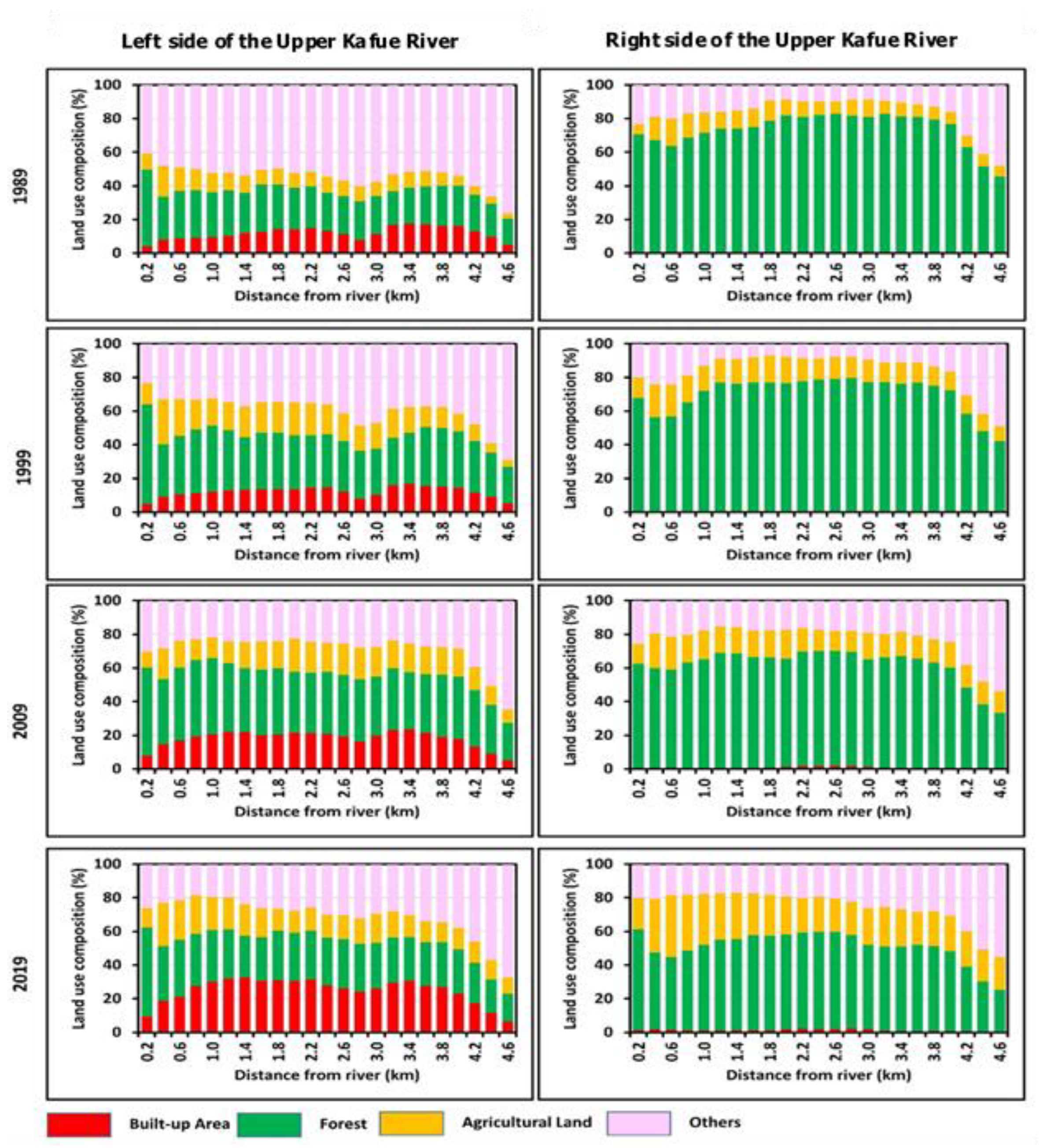
| Sensor | Scene ID | Acquisition Date | Time (GMT) |
|---|---|---|---|
| Landsat-8 OLI/TIRS | LC81720692019156LGN00 | 5 May 2019 | 08:46:15 |
| Landsat-5TM | LT51720692009176JSA02 | 24 May 2009 | 07:30:45 |
| Landsat-5TM | LT51720691999181JSA00 | 2 May 1999 | 07:56:53 |
| Landsat-5TM | LT51720691999181JSA00 | 18 May 1989 | 08:30:33 |
| LULC Class | Description |
|---|---|
| Built-up | Areas with a high concentration of human-made structures and activities, including urban and rural residential zones, commercial and industrial areas, transportation networks, and all impervious surfaces. |
| Forest | Forested areas including customary land forests, plantations, and deciduous and mixed forests, as well as protected forests. |
| Agricultural land | Lands primarily used for crop cultivation at both subsistence and commercial levels. |
| Grassland | Open landscapes predominantly covered by grasses and small shrubs, with minimal tree cover. |
| Bare land | Land with little-to-no vegetation, lacking significant human-made structures. |
| Water | All natural and artificial water bodies, including streams, rivers, lakes, and reservoirs. |
| Symbol | Meaning |
|---|---|
| Nti | intensity of annual net change for category i during time interval [Yt,Yt + 1] relative to size of category i at time point t |
| St | annual change percentage during time interval [Yt,Yt + 1] |
| Ctij | number of pixels that are category i at time t and category j at time point t + 1 |
| Gtj | intensity of annual gain of category j during time interval [Yt,Yt + 1] relative to size of category j at time point t + 1 |
| Lti | intensity of annual loss of category i during time interval [Yt,Yt + 1] relative to size of category i at time point t + 1 |
| i | index for a category |
| j | index for a category |
| J | number of categories |
| t | index for a time point |
| Yt | year at time point t |
| LULC Class | 1989 | 1999 | 2009 | 2019 | ||||
|---|---|---|---|---|---|---|---|---|
| Area (ha) | % | Area (ha) | % | Area (ha) | % | Area (ha) | % | |
| Built-up | 2236.1 | 5.8 | 2278.0 | 5.9 | 3557.1 | 9.2 | 4971.8 | 12.8 |
| Forest | 21,505.8 | 55.5 | 22,362.7 | 57.7 | 21,213.9 | 54.7 | 16,898.9 | 43.6 |
| Agricultural land | 3983.9 | 10.3 | 6112.0 | 15.8 | 6356.2 | 16.4 | 8358.1 | 21.6 |
| Grassland | 126.9 | 0.3 | 85.1 | 0.2 | 411.9 | 1.1 | 1463.0 | 3.8 |
| Bare land | 10,610.7 | 27.4 | 7690.7 | 19.8 | 6856.8 | 17.7 | 66,02.2 | 17.0 |
| Water | 316.8 | 0.8 | 251.8 | 0.6 | 384.3 | 1.0 | 486.3 | 1.3 |
| Total | 38,780.2 | 100 | 38,780.2 | 100 | 38,780.2 | 100 | 38,780.2 | 100 |
| LULC Changes | 1989–1999 | 1999–2009 | 2009–2019 | 1989–2019 | ||||
|---|---|---|---|---|---|---|---|---|
| Area (ha) | Annual Change | Area (ha) | Annual Change | Area (ha) | Annual Change | Area (ha) | Annual Change | |
| Built-up | 41.8 | 4.2 | 1279.1 | 127.9 | 1414.7 | 141.5 | 2735.6 | 91.2 |
| Forest | 856.9 | 85.7 | −1148.8 | −114.9 | −4315.1 | −431.5 | −4606.9 | −153.6 |
| Agricultural land | 2128.1 | 212.8 | 244.2 | 24.4 | 2002.0 | 200.2 | 4374.3 | 145.8 |
| Grassland | −41.9 | −4.2 | 326.9 | 32.7 | 1051.0 | 105.1 | 1336.1 | 44.5 |
| Bare land | −2920.1 | −292.0 | −833.9 | −83.4 | −254.6 | −25.5 | −4008.5 | −133.6 |
| Water | −65.0 | −6.5 | 132.5 | 13.2 | 102.0 | 10.2 | 169.5 | 5.6 |
| LULC Change | 1989–1999 | 1999–2009 | 2009–2019 | 1989–2019 | ||||
|---|---|---|---|---|---|---|---|---|
| Area (ha) | Annual Change (ha/y) | Area (ha) | Annual Change (ha/y) | Area (ha) | Annual Change (ha/y) | Area (ha) | Annual Change (ha/y) | |
| Agricultural land gain from forest | 2760.8 | 276.1 | 2175.3 | 217.5 | 3169.7 | 317.0 | 4895.1 | 163.2 |
| Agricultural land gain from other land cover | 1592.7 | 159.3 | 1522.0 | 152.2 | 1926.5 | 192.7 | 2034.6 | 67.8 |
| Agricultural land lost to other land cover | 595.2 | 59.5 | 902.1 | 90.2 | 1930.0 | 193.0 | 1048.2 | 34.9 |
| Forest gain from agricultural land | 1614.9 | 161.5 | 2506.4 | 250.6 | 840.2 | 84.0 | 1294.7 | 43.2 |
| Built-up land gain from other land cover | 785.5 | 78.6 | 1822.1 | 182.2 | 2186.9 | 218.7 | 3335.5 | 111.2 |
| Other changes | 5305.7 | 530.6 | 5728.5 | 572.9 | 5323.7 | 532.4 | 6771.0 | 225.7 |
| Permanent agricultural land | 1758.4 | 175.8 | 2658.9 | 265.9 | 3411.5 | 341.1 | 1578.0 | 52.6 |
| Permanent built-up area | 1492.5 | 149.2 | 1735.0 | 173.5 | 2773.3 | 277.3 | 1624.7 | 54.2 |
| Permanent forest | 17,151.2 | 1715.1 | 16,440.5 | 1644.0 | 14,420.9 | 1442.1 | 12,811.5 | 427.1 |
| Permanent other lands | 5723.3 | 572.3 | 3289.5 | 329.0 | 2797.6 | 279.8 | 3386.9 | 112.9 |
| 38,780.2 | - | 38,780.2 | - | 38,780.2 | - | 38,780.2 | - | |
Disclaimer/Publisher’s Note: The statements, opinions and data contained in all publications are solely those of the individual author(s) and contributor(s) and not of MDPI and/or the editor(s). MDPI and/or the editor(s) disclaim responsibility for any injury to people or property resulting from any ideas, methods, instructions or products referred to in the content. |
© 2025 by the authors. Licensee MDPI, Basel, Switzerland. This article is an open access article distributed under the terms and conditions of the Creative Commons Attribution (CC BY) license (https://creativecommons.org/licenses/by/4.0/).
Share and Cite
Denga, R.V.; Simwanda, M.; Vinya, R.; Ranagalage, M.; Murayama, Y. Spatiotemporal Patterns of Agriculture Expansion Intensity and Land-Use/Cover Changes in the Mixed Urban-Rural Upper Kafue River Basin of Zambia (1989–2019). Agriculture 2025, 15, 1047. https://doi.org/10.3390/agriculture15101047
Denga RV, Simwanda M, Vinya R, Ranagalage M, Murayama Y. Spatiotemporal Patterns of Agriculture Expansion Intensity and Land-Use/Cover Changes in the Mixed Urban-Rural Upper Kafue River Basin of Zambia (1989–2019). Agriculture. 2025; 15(10):1047. https://doi.org/10.3390/agriculture15101047
Chicago/Turabian StyleDenga, Rudo V., Matamyo Simwanda, Royd Vinya, Manjula Ranagalage, and Yuji Murayama. 2025. "Spatiotemporal Patterns of Agriculture Expansion Intensity and Land-Use/Cover Changes in the Mixed Urban-Rural Upper Kafue River Basin of Zambia (1989–2019)" Agriculture 15, no. 10: 1047. https://doi.org/10.3390/agriculture15101047
APA StyleDenga, R. V., Simwanda, M., Vinya, R., Ranagalage, M., & Murayama, Y. (2025). Spatiotemporal Patterns of Agriculture Expansion Intensity and Land-Use/Cover Changes in the Mixed Urban-Rural Upper Kafue River Basin of Zambia (1989–2019). Agriculture, 15(10), 1047. https://doi.org/10.3390/agriculture15101047








